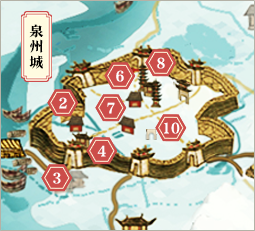
- 1 Jiuri Mountain Wind-Praying Inscriptions
- 2 Site of the Maritime Trade Office
- 3 Site of Deji Gate
- 4 Tianhou Temple
- 5 Zhenwu Temple
- 6 Site of Southern Clan Office
- 7 Confucius Temple and School
- 8 Kaiyuan Temple
- 9 Statue of Lao Tze
- 10 Qingjing Mosque
- 11 Islamic Tombs
- 12 Statue of Mani in Cao’an Temple
- 13 Sites of Cizao Kilns (Jinjiaoyishan Kilns)
- 14 Sites of Dehua Kilns (Weilin-Neiban Kilns and Q...
- 15 Xiacaopu Iron Production Site of Qingyang Villa...
- 16 Luoyang Bridge
- 17 Anping Bridge
- 18 Site of Shunji Bridge
- 19 Estuary Docks
- 20 Shihu Dock
- 21 Liusheng Pagoda
- 22 Wanshou Pagoda

史迹地图
-

Jiuri Mountain Wind-Praying Inscriptions
The Jiuri Mountain Wind-Praying Inscriptions are a representative component reflecting the Institutional Guarantee of Quanzhou as a world maritime trade emporium. They are cliff-face inscriptions recording the ritual ceremonies held by state commissioners in charge of overseas trade, local officials and members of the imperial clan in the Song Dynasty to pray for propitious winds to aid the overseas trade shipping business. They reflect the power that the state enjoyed under the Song D... -
Site of the Maritime Trade Office
The Maritime Trade Office in Quanzhou was established in 1087 by the Song and Yuan regimes to manage the city’s maritime trade affairs. It was located on the bank of the Jinjiang River in the southern part of the city of Quanzhou, outside Zhennan Gate of Luocheng (“outer wall” of the old city of Quanzhou) and inside Nanxun Gate of Yicheng (“wing wall”). The ongoing archaeological excavation has uncovered Song-Yuan ground remains in two trial trenches. These two pavements may have ... -

Site of Deji Gate
The Site of Deji Gate is a representative component testifying to the Institutional Guarantee of Quanzhou as a maritime trade emporium of the world. The site holds what remains of the southern city gate from the Song-Yuan era and bears a testimony to the history of the city’s southward expansion. As a major landmark within the commercial district on the south side of the city, the Site of Deji Gate stands testament to the government’s administrative assurance for the development of m... -

Tianhou Temple
Tianhou Temple is a representative component reflecting the Institutional Guarantee of ancient Quanzhou as the world maritime trade emporium. The temple bears witness to the formation and development of Mazu belief amidst maritime trade, and reveals how folk beliefs and the will of the state worked in concert to advance maritime trade. The temple is located on the southern end of the ancient city of Quanzhou, facing the Jinjiang River and the coastal ports to the south. It is dedicated... -

Zhenwu Temple
Zhenwu Temple is a representative component reflecting the Institutiaonl Guarantee of Quanzhou as the emporium of world maritime trade. Founded in the era of the Song and Yuan dynasties and dedicated to the worship of Emperor Zhenwu, this Daoist temple served as an important landmark within the ancient port of Fashi. The temple was an important source of spiritual support for merchants engaged in maritime trade and was the venue chose by Quanzhou officials to make their sacrifices to t... -

Site of Southern Clan Office
The Site of Southern Clan Office is a representative component that highlights the Multi-cultural Communities at the world maritime trade emporium. The Southern Clan Office was an administrative agency established for the Song Dynasty kinsmen who relocated to Quanzhou in 1130 and thereafter. The site is located to the southwest of the city’s Suqing Gate and south of Kaiyuan Temple. Archaeological excavations have yielded two architectural foundations, the remains of retaining walls an... -

Confucius Temple and School
The Confucius Temple is a representative component reflecting the Multi-cultural Communities of the city as an emporium of world maritime trade. It is a place for Confucians to offer sacrifice and the city’s highest institute of education. The social elites it cultivated played an important role in the development and management of Song-Yuan-era maritime trade. The Confucius Temple and School is located in what was once the northeast of Quanzhou city in the 10th century. Construction ... -

Kaiyuan Temple
Kaiyuan Temple is a representative component reflecting the Multi-cultural Communities of Quanzhou as the world maritime trade emporium. As a result of maritime trade, its economic and diverse cultural relics reflect the economic prosperity and the fusion of diverse cultures of Quanzhou in the Song and Yuan eras. It also testifies to the significant contributions of rulers of the regional regime, Song and Yuan government officials, monks and powerful local clans to the city’s socio-ec... -

Statue of Lao Tze
The Statue of Lao Tze is a representative component reflecting the Multi-cultural Communities in Quanzhou as a world maritime trade emporium. It is a massive stone statue of Lao Tze, founder of Taoism. It reveals the unique historical context of Quanzhou as a world maritime trade center sustained by the agricultural empire; it also reflects the flourishing diverse cultures in Quanzhou as a world maritime trade emporium, as well as the prosperity and achievements of the port. The Statue... -

Qingjing Mosque
Qingjing Mosque is a representative component that reflects the Multi-cultural Communities of the city as a world maritime trade emorium. Together, Qingjing Mosque and the Islamic Tombs are testaments to the culture, religion and lifestyles of foreign peoples that were active in Quanzhou during that time. They also serve as evidence that help us better understand the population accumulation, trade and diverse cultural history of this city in Song and Yuan eras. Originally named Masjid ... -

Islamic Tombs
The Islamic Tombs constitute a representative component that highlights the Multi-cultural Communities at the emporium of world maritime trade. The Islamic Tombs are located in the southern foothills of Lingshan Mountain, two kilometers from the east gate of the city of Quanzhou. They are believed to be the final resting places of two Muslims who came to Quanzhou in the 7th century. Major renovations were undertaken on the tombs in 1322. Facing southward, the tombs are built into the m... -

Statue of Mani in Cao’an Temple
The Statue of Mani in Cao’an Temple is a representative component reflecting the Multi-cultural Communities in Quanzhou as the emporium of world maritime trade. Cao’an Temple, located at the eastern foot of Huabiao Hill 15 kilometers south of the city of Quanzhou, is a temple of Manichaeism (also known as the “Mingjiao” or the Religion of Light) in the outer suburbs of Quanzhou dating to the Song-Yuan era. The temple enshrines a stone statue of Mani, founder of Manichaeism. Carved ... -

Sites of Cizao Kilns (Jinjiaoyishan Kilns)
The Sites of Cizao Kilns (Jinjiaoyishan Kilns) constitute a representative component that reflects the Production Sites of export commodities of Quanzhou as an emporium of world maritime trade. They are outstanding examples of the export-porcelain kiln sites that dotted the outskirts of Quanzhou in the Song-Yuan era. They demonstrate the prominence of craft production for exportation in the industrial structure of Quanzhou as the emporium of the world in Song-Yuan China. Cizao Kilns ar... -

Sites of Dehua Kilns (Weilin-Neiban Kilns and Q...
The Sites of Dehua Kilns (Weilin-Neiban Kilns and Qudougong Kiln) are a representative component of the Production Sites of Quanzhou as an emporium of world maritime trade. Dehua Kilns are located in Dehua County, about 70 kilometers northwest of Quanzhou City, and are representative of the porcelain production kiln site groups in Quanzhou’s hinterland area. Dehua Kilns began production in the late Tang Dynasty. The kilns then underwent major development in the Song-Yuan era against a... -

Xiacaopu Iron Production Site of Qingyang Villa...
The Xiaocaopu Iron Production Site of Qingyang Village in Anxi is a representative component of the export Production Sites in Quanzhou as an emporium of world maritime trade. It is situated in the Daiyun Mountain region about 70 kilometers northwest of Quanzhou. Qingyang Village in Anxi was one of the dedicated iron plants set up by the government in the Song Dynasty. The Xiaocaopu Iron Production Site of Qingyang Village is located on the hillside in the south of Qingyang Village, co... -

Luoyang Bridge
Luoyang Bridge is a representative component reflecting the Transportation Network of Quanzhou as an emporium of world maritime trade. Luoyang Bridge is situated at the mouth of the Luoyang River about 10 kilometers northeast of Quanzhou city. It was originally known as Wan’an Bridge as it was near the ancient Wan’an Ferry. It was a vital transportation link connecting Quanzhou to northern Fujian and the interior regions. Construction began on Luoyang Bridge in 1053 and was completed... -

Anping Bridge
Anping Bridge is a representative component reflecting the Transportation Network of Quanzhou as an emporium of world maritime trade. Anping Bridge is located 30 kilometers southwest of Quanzhou city in a bay at the juncture between Anhai in Jinjiang and Shuitou in Nan’an. The bridge was the main link between Quanzhou and Zhangzhou and Guangzhou to the south. It is also known as Five Li Bridge due to its length, which is around five li (one li measures around 500 meters) and is China... -

Site of Shunji Bridge
Shunji Bridge is a representative component reflecting Quanzhou’s Transportation Network as an emporium of world maritime trade. It was the node of land transport between the ancient city of Quanzhou and the south bank of the Jinjiang River, facilitating maritime trade in Quanzhou. As the main access to ancient Quanzhou’s commercial district, the bridge enhanced the city’s water-land transshipment system. The site of Shunji Bridge is located outside Deji Gate, the southern entrance ... -

Estuary Docks
Estuary Docks are a representative component reflecting the Transportation Network of Quanzhou as an emporium of world maritime trade. They are located in the southeast of Quanzhou’s old city on the northern banks of the Jinjiang River. They were a water-land transshipment node connecting with the old city. Along with Zhenwu Temple, they are precious historical remains at Fashi Port, a major inner port on the outskirts of Quanzhou. Wenxing Dock and Meishan Dock have been preserved to ... -

Shihu Dock
Shihu Dock is a representative component reflecting the Transportation Network of Quanzhou as an emporium of world maritime trade. It is an invaluable piece of physical evidence of Quanzhou’s outer port docks. This dock, together with Estuary Docks, demonstrates Quanzhou Port’s water-land transshipment system during the Song and Yuan periods. Shihu Dock is located on the western shore of Shihu Peninsula, 17 kilometers south of Quanzhou city. It utilized natural reefs in its construct... -

Liusheng Pagoda
Liusheng Pagoda is a representative component offering unique insight into the Transportation Network of ancient Quanzhou as an emporium of world maritime trade. It is an important historical site at Shihu Port that marked where merchant ships would shift course from the main shipping line in Quanzhou Bay to the inner ports. Liusheng Pagoda is located on Jinchai Hill (also known as Yandun Hill) on the northern tip of Shihu Peninsula, in the center of Quanzhou Bay. It is a stone pagoda ... -

Wanshou Pagoda
Wanshou Pagoda is a representative component reflecting the Transportation Network of Quanzhou as an emporium of world maritime trade. It was the landmark for merchant ships arriving at the port of Quanzhou; it also served as a source of spiritual support for the local population by safeguarding the bay and providing divine protection for traveling merchant. Wanshou Pagoda sits atop Baogai Hill, 20 kilometers southeast of Quanzhou city. It is a stone pagoda styled to imitate a wooden p...
 闽公安备35050302000734
闽公安备35050302000734
